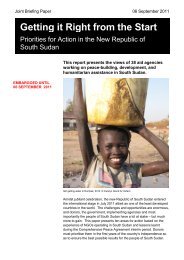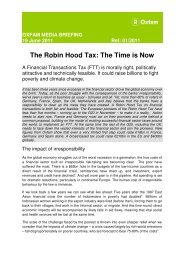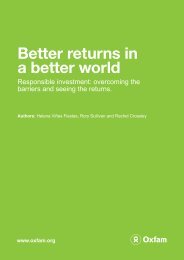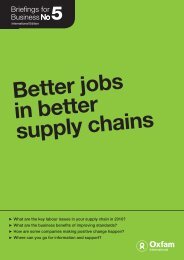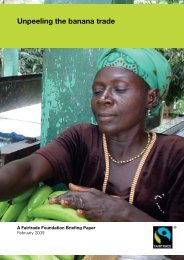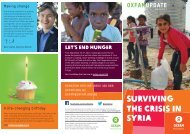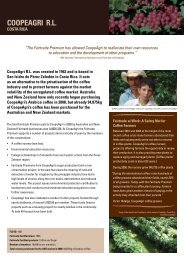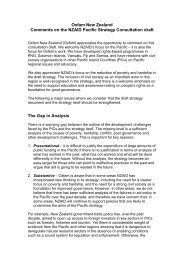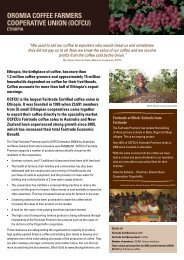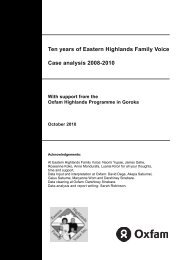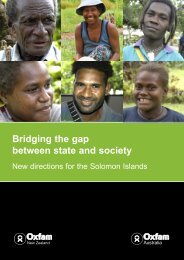Growing a Better Future - Oxfam International
Growing a Better Future - Oxfam International
Growing a Better Future - Oxfam International
- No tags were found...
You also want an ePaper? Increase the reach of your titles
YUMPU automatically turns print PDFs into web optimized ePapers that Google loves.
Notes1 http://data.worldbank.org2 In Niger 44 per cent of children suffer from chronic malnutrition,World Food Programme, http://www.wfp.org/countries/niger3 http://hdrstats.undp.org4 http://www.fao.org/hunger/hunger_graphics/en/5 J. Von Braun (2008) ‘Food and Financial Crises: Implications forAgriculture and the Poor’, IFPRI Food Policy Report. WashingtonDC: <strong>International</strong> Food Policy Research Institute.6 http://www.fao.org/news/story/0/item/20568/icode/en/7 For example, Nike and Apple publicly left the US Chambers ofCommerce when it refused to back US climate legislation. http://www.businessgreen.com/bg/news/1800576/greenpeace-heatoil-giants-linked-astroturf-protests8 http://www.unep.org/publications/ebooks/annual-report09/Content.aspx?id=ID0EXEAC9 The IPCC AR4 Working Group on Mitigation (Working Group III)found that, ‘For the lowest mitigation scenario categoryassessed, CO2 emissions would need to peak by 2015’. See:IPCC (2007) ‘Climate Change 2007: Synthesis Report, AnAssessment of the Intergovernmental Panel on Climate Change’,Geneva: IPCC: Footnote 20.10 FAO (2009) ‘How to Feed the World in 2050’.11 http://esa.un.org/wup2009/unup/index.asp?panel=112 <strong>Oxfam</strong> calculations based on http://faostat.fao.org/site/452/default.aspx13 HSBC (2011) ‘The world in 2050’.14 M. Cecchini, F. Sassi, J.A. Lauer, Yong Y Lee, V. Guajardo-Barron, D. Chisholm (2010) ‘Tackling of unhealthy diets, physicalactivity, and obesity: health effects and cost-effectiveness’, TheLancet, Vol. 376, 20 November 2010, pp.1775–83.15 Foresight (2007) ‘Tackling Obesities: <strong>Future</strong> Choices’, TheGovernment Office for Science, London. In the developing worldobesity tends to be concentrated in the middle classes – thosewho lead more sedentary lifestyles and consume moreprocessed foods; in the rich world it is a scourge of poor people,because healthy foods are frequently more expensive. In theUSA, seven of the ten states with the highest poverty levels arealso among the ten states with the highest rates of obesity, http://www.nytimes.com/2009/08/11/health/11stat.html?_r=1&ref=science16 http://www.ers.usda.gov/Publications/WRS0801/ R. Trostle(2008) ‘Global Agricultural Supply and Demand: FactorsContributing to the Recent Increase in Food Commodity Prices’.Demand for food is expected to increase at an average rate over1.3 per cent per year through to 2050 (average compound growthrate, based upon a 70 per cent increase in demand by 2050).17 R. Trostle (2008), op. cit.18 The total area under irrigation is forecast to increase by only 9per cent between 2000 and 2050, Global Water Security (2010)‘Engineering the <strong>Future</strong>’. See also Bruinsma (2009) ‘TheResource Outlook to 2050: By How Much Do Land, Water Useand Crop Yields Need to Increase by 2050?’, paper presented atthe Expert Meeting on How to Feed the World in 2050, Food andAgriculture Organization of the United Nations, Rome. Thisargues that the area equipped for irrigation could increase by 11per cent from 2005 to 2050, with the expansion concentrated inEast and South Asia, and Near East/North Africa.19 In the semi-arid tropics – which lie primarily in developingcountries where agriculture is almost entirely rain-fed and largelycomprises poor, smallholder farms – potential yields under highinputs and advanced management are on average 3.6 timesmore than current average yields. Soil moisture managementand rainwater harvesting could add an additional 10% onaverage to these high input potentials, while further reducing thevariability in yields and number of failure years. See http://www.iwmi.cgiar.org/assessment/files_new/publications/ICRISATReport_54.pdf20 Calculated from OECD DAC5 database ‘Official BilateralCommitments by Sector’; includes forestry and fishing.21 OECD Producer Support Estimate in 2006 was $252,508m, seehttp://www.oecd.org/dataoecd/30/58/45560148.xls?contentId=4556014922 OECD ODA on agriculture in 2006 was $3.2bn.23 OECD (2009) ‘Agricultural Policies in OECD Countries:Monitoring and Evaluation 2009’.24 Legrain (2010) ‘Beyond CAP: Why the EU Budget NeedsReform’, the Lisbon Council e-brief, Issue 09/2010.25 Rich countries were estimated to be spending at least $13–15bna year on biofuel subsidies in the run-up to the 2008 food pricecrisis. Increasing demand for biofuels was estimated to accountfor about 30 per cent of food price rises over the period inquestion, <strong>Oxfam</strong> (2008) ‘Another Inconvenient Truth’, http://www.oxfam.org/en/campaigns/climatechange/highlights26 <strong>Oxfam</strong> <strong>International</strong> (2010) ‘Halving Hunger’, http://www.oxfam.org/en/policy/halving-hunger-still-possible27 World Bank, http://is.gd/P5cylT28 One major review recently concluded that ‘we should work on theassumption that there is little new land for agriculture’, Foresight(2011) ‘The <strong>Future</strong> of Food and Farming, Final Project Report’,The Government Office for Science, London, http://www.bis.gov.uk/foresight/our-work/projects/current-projects/global-food-andfarming-futures/reports-and-publications.Another quantifies‘little’ as an increase in arable area of 12.4 per cent in thedeveloping world – where the vast majority of potential new landis found – by 2050, see http://goo.gl/64ZAI29 http://goo.gl/64ZAI p13.30 D. Molden (ed.) (2007) Water for Food, Water for Life: AComprehensive Assessment of Water Management, London:Earthscan, and Colombo: <strong>International</strong> Water ManagementInstitute.31 R. Clarke and J. King (2004) The Atlas of Water, London:Earthscan Books.32 http://www.bis.gov.uk/go-science/news/speeches/the-perfectstorm33 http://www.iwmi.cgiar.org/assessment/files_new/synthesis/Summary_SynthesisBook.pdf34 Brown (2011) ‘The Great Food Crisis of 2011’, Foreign Policy,January 10, 2011.35 Middle Eastern states are estimated to account for over a fifth ofidentified investments in sub-Saharan Africa. http://www.commercialpressuresonland.org/monitoring-land-transactions]36 Demand for land in Africa has been estimated by the World Bankas 39.7m hectares in 2009, compared with a mean annual areaexpansion of 1.7m hectares over the period 1961–2007.37 From preliminary data of a monitoring project of large-scale landacquisitions by <strong>Oxfam</strong>, CIRAD, CDE at University of Bern, and<strong>International</strong> Land Coalition. The data (March 2011) is currentlybeing verified and will be released in full in September 2011.Land deals included in the database run from 2001 onwards,though the majority of deals are from 2007 to 2011.68



